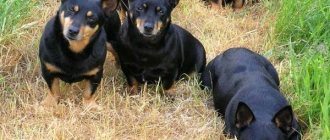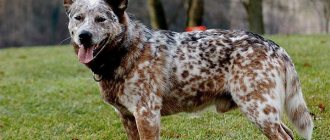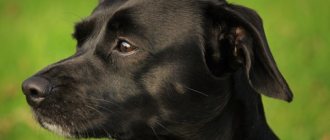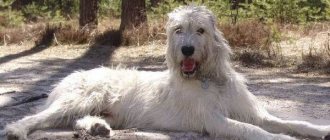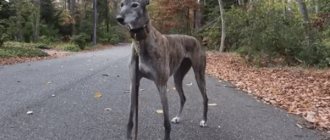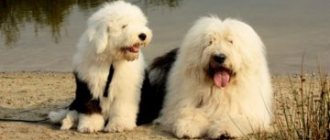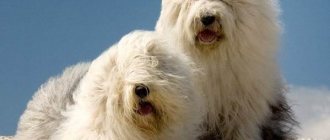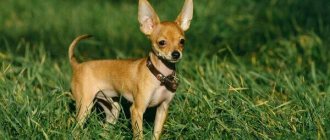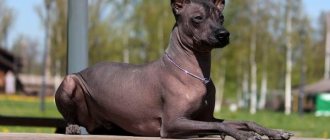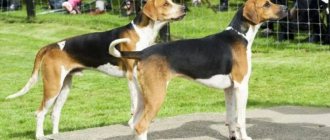| Type |
|
| Size | medium (11-25kg) |
| Main features |
|
| Included in |
|
| Intelligence | 60% |
Australian heeler. Video
Content
- History of the Australian Heeler dog breed
- Appearance of the Australian Kettle breed
- Character
- Pros and cons of the Australian Heeler breed
- Education and training
- Care and maintenance
- Health and illness
- How to choose a puppy and where to buy an Australian Heeler
- How much do Australian Heeler puppies cost?
The Australian Heeler is an energetic and hardy dog that can become a faithful companion and reliable protector. And if necessary, he will be a manager, a sort of middle-level manager under the owner. See for yourself: the heeler's sharp ears are always listening warily, his intelligent eyes are peering attentively, his tail is slightly raised. One word - and he will rush to carry out the boss's instructions.
A tireless herding dog, specially bred for driving livestock, will be an excellent assistant for a farmer or villager. Australian Kettles, which is the second name of the breed, have found their place in the city. Sports dogs successfully perform in agility and show good results in police service.
At home, the Australian Heeler will be happy to carry out the commands of the owner-leader, control the members of the “pack” and defend the territory. These dogs do not like strangers, and they also do not tolerate idleness and boredom. They need movement in all forms.
Want to know more about the Australian Heeler dog, keep reading.
History of the Australian Kettle breed
This dog breed, as the name suggests, was developed in Australia. In the 19th century, migrant farmers from Great Britain faced a problem. The black bobtails, which they brought from their homeland as helpers for grazing and driving livestock, were not up to the task. The local climate turned out to be too hot for the shaggy and heavy dogs. They could not protect the herds from the aborigines, short-haired and fast dingoes.
To solve the problem, cattle breeders tried to crossbreed wild dogs and bobtails, but they were not entirely happy with the result. Then the blood of short-haired Scottish Shepherds was added to the crossbreed, and then Dalmatians and Kelpies. The result was an ideal herding dog. It was perfectly adapted to the arid and hot climate of Australia and had excellent performance characteristics.
Australian Kettle Dogs were distinguished by incredible endurance; they could tirelessly run long distances. In addition, the dogs were smart and well trained in herding.
The Australian Cattle Dog quickly gained popularity among local farmers. The first Australian Heeler breed standard was approved in 1963 by the National Kennel Council of Australia. This was followed by worldwide recognition.
It is no coincidence that the new breed of shepherd dogs was named this way. The word heel in English means heel. Australian heelers have found an original way to manage herds. To gather livestock or guide them in the right direction, they bite the animals' legs.
These dogs began to be exported to other continents relatively recently. At first, the Australian heeler was appreciated by cattle breeders from America and Canada. In Europe, the first representatives of the new breed appeared in the 70s of the last century. Russian dog breeders became acquainted with Australian kettles much later, only in 2004.
Description, appearance of the Australian Shepherd
The height of an adult Australian Shepherd does not exceed 56-58 cm. This breed received the status of a herding dog for its ability to very easily cope with herding a large herd or flock. Coat coloring can vary, but the most common variations are marbled red or marbled blue.
Breed standards
According to the FCI classification, the Australian Shepherd has very correct proportions, a slightly elongated body, medium size and the following standards:
- the head is clearly defined, strong and dry, proportional to the body, with a small occipital protuberance and a moderate or well-defined stop. The pigmentation of the nose and lips varies depending on the color of the coat and can be black or light brown. The presence of pink spots is allowed, the number of which should not exceed a quarter of the total surface;
- the muzzle is cone-shaped, with a characteristic rounding at the end. The teeth should have a scissor or level bite. The eyes are almond-shaped, with different types of eyelid pigmentation. The ears are triangular, medium in size, set high on the head;
- The neck is strong and of medium length, slightly arched at the nape and set evenly on the shoulders. The back is straight and strong enough, strong and even all the way from the withers to the hip joints. The croup area is moderately sloping. The chest is not too wide, deep, with elastic and long, not barrel-shaped ribs. The abdomen is moderately tucked. A straight tail can be naturally long or naturally short;
- the forelimbs have straight and strong paws and are distinguished by strong, oval rather than round bones. Oval feet are compact, distinguished by collected and fairly curved toes with thick and elastic pads. The hind limbs have well-defined and moderately arched stifles, and the feet are oval and compact with thick, elastic pads.
The coat is not too long, has average density, can be straight or wavy, with sufficient resistance to any adverse weather factors. The hair on the head and front of the limbs is short and soft. There is a small mane and a characteristic frill, which are most pronounced in males.
Australian Shepherd personality
The movements of the Australian Shepherd are smooth, free and easy. An adult dog can demonstrate agility in its movements and a well-balanced run that trails along the ground. The movement of the front and hind legs is straight and parallel to the center line of the body. The Australian Shepherd is an agile breed and can quickly change direction and manner of movement.
The Australian Shepherd is a very loyal breed and will become a loyal friend to both adults and children. Among other things, this dog is an ideal and attentive student, grasping all knowledge very quickly. The breed loves active games and frequent walks, and expects attention and frequent approval from the owner. This is a very reliable, but completely unobtrusive and hardworking companion.
Appearance of the Australian Heeler breed
The breed standard states that the Australian Heeler should be compact and proportionate. This is a medium sized dog. The height of males at the withers is not lower than 44 cm and not higher than 51 cm, weight from 15 to 23 kg. Bitches are slightly smaller and lighter, height 42-50 cm, weight at least 15 kg.
The Australian Kettle's appearance combines strength and endurance. This muscular dog is harmoniously built, but should not be rough.
The Kettle's head is proportional and quite wide. The transition between the forehead and muzzle is well defined. The nose is wide at the base, becomes narrower towards the lobe, its color is only black.
The Australian Heeler has strong jaws with healthy teeth. For a herding dog this is of particular importance.
The eyes should be medium in size, with dark brown irises, and intelligent. The dog looks calm and confident. When strangers or some other danger appears, his gaze becomes more attentive and wary. The dog seems to warn someone who encroaches on its territory or pack.
The Australian Heeler's ears are not very large and erect. They are spaced wide apart and directed slightly to the side. If something worries the dog, it turns its ears straight forward.
The shepherd dog has a muscular neck that extends into a powerful chest and strong body. She has a straight back and a lean stomach. The limbs are well developed, strong, but not overloaded with muscles.
The tail is set quite low, and when relaxed it falls almost to the joints. A fluffier “brush” is clearly visible at the end. An excited dog raises its tail, but it should not be higher than its back.
The Australian Heeler breed has a smooth, rough coat that repels water. The length of hair on the body is on average 2.5 - 4 cm. The undercoat is approximately half as long, thick and dense. Slight feathering on the hind legs is normal. Excessive fluffiness, as well as too short fur, are vices.
The color of the Australian Kettle can be blue or blue, blue-speckled, as well as red and red-speckled. Symmetrical markings of black, bluish or yellowish-red are allowed on the muzzle; sometimes there is a “mask”. Black spots on the body are undesirable. Possible, but not obligatory, tan on the limbs, chest and throat with transition to the jaws and cheekbones, on the back of the inner thighs and paws.
The Australian heeler moves easily and naturally, and is particularly swift. As they say: he rushes right off the bat. He can run a long distance and hardly get tired at all. And then quickly regain strength.
Serious breed defects include:
- Weak front and hind limbs
- Straight shoulder blades and straight knees
- Wrong position: cow or goat
- Yellow or blue eye color
- Unnatural, related movements
Dogs with obvious deviations in appearance and physical condition, as well as with significant behavioral problems, are disqualified. The vice for the Australian Heeler breed is both excessive timidity and excessive aggression.
Breed Features
This dog's appearance is quite bright - the animal cannot be confused with any other. That is why most first meetings with representatives of this breed end in the person’s boundless love for this dog. Let's take a closer look at what makes this animal fall in love with it.
Did you know? Dogs are able to remember about 250 commands, which are expressed using all kinds of gestures or sounds.
Appearance and photo
- Life expectancy: about 15 years.
- Group: herding dogs.
- Who recognizes the breed: CKC, FCI, AKC, UKC, ANKC, NKC, NZKC, APRI, ACR.
- Coat color: dark blue or red; some individuals have a characteristic small white spot on the forehead.
- Coat length: medium.
- Shedding: moderate.
- Height at withers: 43-51 cm.
- Weight: 14-16 kg.
- Country: Australia.
According to the official description of the breed, the Australian Cattle Dog is an animal with a powerful and muscular build. Despite their sluggishness and, at first glance, clumsiness, individuals of the breed are distinguished by good dexterity and agility, with which the dog manages to impress quite a lot of people. The length of the animal’s body exceeds its height; any other general body shape automatically indicates that the dog is not purebred.
The main features of the appearance of a heeler, which characterize the individual’s belonging to a purebred breed:
- hanging tail;
- the front legs are perfectly straight, without any irregularities;
- the head is wide, its shape tends to ideal roundness, the muzzle is large;
- the ears are set wide apart, the tips are pointed, and fur grows on the inside of the ears;
- eyes are small, oval, brown in color;
- powerful jaws, scissor bite;
- exclusively black color of the nose;
- the neck is powerful and muscular, the back is straight;
- The chest is wide, the ribs stand out perfectly on the body;
- the paws are round, the claws are strongly curved.
Did you know? Unlike popular opinion, dogs do not like to be hugged or stroked on the head; for the animal, these gestures are regarded as a sign of obvious dominance.
Character and psychology of a dog
Initially, this breed was bred for the purpose of herding livestock and protecting it from predators, so the dog is distinguished by endurance and high mental abilities. This is a watchdog, so cowardice is unusual for him. In the most critical situations, the animal is ready to lay down its life so that the protected object remains completely intact and safe. In addition, over time, these animals have shown themselves to be devoted and faithful pets, so any individual can be taught and trained quite well.
But this dog is famous not only for its excellent working qualities. In addition to their strong and persistent character, dogs are distinguished by their good nature, affection and true love for people. These are loving and energetic dogs, capable of complete dedication for the sake of their owner. These qualities played a decisive role in turning this dog from a purely working breed into a family pet and one of the best companion dogs.
Also herding dogs include such breeds as: Alabai, Border Collie, Welsh Corgi, Caucasian Shepherd, Briard and Bernese Mountain Dog.
Important! The Australian Cattle Dog is not an animal for avid careerists; the dog requires constant attention and daily long walks in the fresh air.
Therefore, if you are unable to provide the animal with enough of your time, focus on another breed
Character
The Australian Heeler is not a toy dog. Therefore, she is valued not so much for her beauty and external compliance with standards, but for her character and working qualities. Although the breed standard also says a lot about this. So, what is the character of the ideal Australian Heeler?
The main qualities are deep loyalty and devotion to the owner, as well as obedience. In addition, the herding dog has a pronounced protective instinct. She should be distrustful of strangers or animals.
Other mandatory qualities are courage and high intelligence, this is inherent from birth. At home, Australian Kettles are engaged in driving cattle over long distances. Sometimes the owner is not around, and then the dog must make decisions himself and be responsible for the safety of the herd. Therefore, the breed, according to animal psychologists, is one of the ten smartest dogs. And owners of healers note that their pets sometimes show incredible cunning.
Also, healers are real hard workers. They love to work and carry out their duties zealously. If they are not assigned to work, they will become sour and bored. “Unemployed” dogs will find something to do on their own, but not always harmless. So you shouldn’t let the Australian healer’s busy schedule take its course.
Experts of this breed assure that these dogs are very sociable and affectionate. These are the best hugging and smiling dogs. They follow the heels of their loved one, try to catch every word, understand the mood.
Heelers are similar in activity to terriers, but they calm down much faster. By temperament they are closer to sanguine people, so they are easier to manage. But the dog will obey only the leader of the pack, his master.
Heeler has the utmost respect for hierarchy. He must know his place in the family and understand who is in charge in the house. A well-mannered dog will obey an authoritative leader. Other members of the pack: cats, smaller and weaker pets, can be looked after or “built”. Although in general these dogs are friendly and get along well with all household members.
Australian Kettles love children; they will enthusiastically take part in outdoor games. But they will not tolerate excessive pestering and overly intrusive attention. It is better not to leave children under four years of age alone with a dog. You can only get this dog for a teenage child, who will be able to raise him himself.
Australian healers are neutral towards strangers. As long as they do not violate the boundaries of the territory that the dog considers its own. If a potential threat arises, the dog will be alert and will track the object. To relieve tension, you need to switch his attention.
The Australian Heeler is a cheerful dog with a sense of humor. She rejoices and even smiles slyly when she makes people laugh and amuse herself.
But other people’s dogs “turn on heelers,” and males are especially concerned about this. They will definitely start to find out who is cooler here. But they won’t attack right away; first they will examine, sniff, and growl. If the stranger persists and also shows character, a fight may break out. Therefore, it is better to resolve such situations before the conflict begins.
These dogs are not recommended for very busy people who are rarely at home. Australian Kettles have a hard time withstanding loneliness. They are sad and may start acting up, howling or barking. By the way, their voice is unique. Some people think it resembles the hooting of an owl. But not all heelers are “talkative”; there are also silent ones in this breed.
It is not recommended for sedentary people to adopt a puppy of this breed. For health and mood, a healer needs a lot of movement, active games and activities.
Pros and cons of the Australian Heeler breed
The Australian Heeler is a versatile dog. But like every breed, it has its own positive and negative qualities. It is worth warning that what follows will be about dogs that have been properly raised.
If you are told that a heeler dog is aggressive towards children, chews everything and howls even in the sun, you do not need to believe blindly. In 99 cases out of 100, problems are the result of improper upbringing or lack thereof.
Strengths of the Australian Heeler breed:
- High intelligence
- Excellent learning ability
- Energetic temperament
- Compact size
- Good health
- Devotion
- Affectionate towards your own people
- Good with children
- Active and curious.
Weaknesses and disadvantages:
- Requires significant physical activity
- Suffering if forced to live passively
- He needs some serious training
- Finds it difficult to bear loneliness
- Sometimes intolerant of other people's dogs.
As you have seen, the Australian Heeler breed has many more advantages than disadvantages. Moreover, there will be no disadvantages at all if you have chosen the right dog and devote time and attention to its upbringing.
Brief characteristics of the breed representatives
The character of Australian Shepherd dogs is calm and friendly. Their content most often does not cause any particular difficulties. These pets are not fussy about feeding. They get along well with other animals and children.
Who are they suitable for?
Cynologists recommend getting an Australian dog for those who want a cheerful, energetic and active pet with whom they can spend their free time until sunset
The main thing is to be able to relax with your pet and give it your attention.
Who is better to choose: a male or a female?
If the male is castrated and the female is sterilized, there is practically no difference between them. This is due to the fact that such pets have approximately the same hormone levels.
If you choose an unsterilized female dog, you need to be prepared for the fact that she will go into heat every six months for 3 weeks. If you do not want puppies, the dog should be isolated during this period.
Can I keep it in an apartment?
Aussies require large areas to play and roam. That is why dog experts recommend that owners of country houses have such pets. However, you can also keep a dog in your apartment. You should be prepared for daily walks.
What is better to feed an Australian Shepherd: dry food or natural food?
The Australian Shepherd can be fed both dry food and natural food. Preference for one method or another should be given directly by the pet owner himself.
Dry food is distinguished by the absence of the need for pre-treatment, long shelf life and a balanced content of nutrients. Its main disadvantage is its significant cost.
As natural food, you can use meat, fish, dairy products, buckwheat, rice, oatmeal, vegetables, fruits and eggs.
Is it easy to train?
The Australian Shepherd Ossie is one of the breeds that is easy to train. She learns new commands very quickly and carries them out with pleasure if she approaches this activity correctly. For the training to be noticeably effective, it must be done regularly. The dog should exercise for as long a period of time as possible. At the same time, it is worth limiting agility exercises, and selecting complexes based on ingenuity.
How are Australian Shepherds used?
Currently, Australian Shepherds are used primarily in the United States. They help guard the herds of animals on the ranch. This breed is considered to be a good companion. Sometimes Australian dogs are used as utility dogs. They can help people with limited mobility navigate in space.
Education and training
There are a lot of negative stories and rumors about Australian heelers. Allegedly, these dogs are too capricious, uncontrollable, they chew and destroy everything. As if they should absolutely not be kept in an apartment and should under no circumstances be owned by inexperienced dog breeders.
As already mentioned, almost all difficulties arise due to a lack of understanding of the essence of the dog’s breed and inadequate upbringing.
First skills
The future owner of an Australian Kettle should have a good understanding of all the features of a herding dog. This is not a soft and fluffy creature, but a serious and rather independent dog. His upbringing needs to be done from the very first days.
The owner must set rules for the puppy, and then calmly and patiently explain to the pet what is required of him. The little heeler needs to be praised more often; for these dogs, kind words and affection are the best encouragement. Sometimes it is worth reinforcing praise with a treat.
It is normal if the puppy at first begins to grab the owner and other family members by the legs. These are the instinctive movements of a herding dog. There is no need to punish for this, but such behavior must be firmly stopped. It’s enough to say “no” and move the baby away a little, as a puppy’s mother would do. At first, when making contact, you need to imitate her behavior. Then only words will be enough.
Breeders and lovers of Australian Heelers claim that these dogs already at a young age try to understand what the owner wants. They focus their attention on him, look into his eyes. Thanks to this, training and education are easy. These dogs learn not only commands, but also individual words and phrases. The main thing is to stick to one line and not change the established rules.
The Australian Heeler is a cunning and smart dog. If he feels weak, it will be difficult to return him to his place.
From the first days, the little healer must learn who is the head of the family or the leader of the pack. The puppy must obey this person unquestioningly. In adolescence, he can compete for leadership, this is especially typical for male dogs. Such attempts must be stopped immediately.
Regarding the damage to things. In this regard, heelers are no better, but no worse than other breeds. If you immediately provide the puppy with toys, give them bones, unnecessary objects, he will not encroach on the furniture or carpet. In addition, these dogs are good at distinguishing between their own and other people's things. They will carefully bring to the litter everything that belongs to them, but will not touch the owner’s property.
What to do with an Australian Heeler puppy
An excellent way to prevent bad behavior is a lot of movement, varied experiences and games. An energetic Australian heeler should let off steam often, run and jump to his heart's content. He will be grateful if you take him on a bike or ski trip, offer to chase Frisbee plates, or simply repeat the “fetch” command repeatedly. A dog that has had a blast, given its all, will not become mischievous at home.
Healers love to learn; they, like excellent schoolchildren, look forward to lessons and complete assignments with zeal. General training courses, agility and other sports are suitable for them. Ideally, a young dog should be trained in a group setting. This way the puppy will gain socialization skills and get used to being calmer towards other dogs.
a brief description of
The Australian Heeler is a herding dog breed that is distinguished by its tirelessness, great endurance and high performance. This is a fearless protector, a loyal friend and a reliable life partner. If you decide to get such a pet, then be prepared for devotion and great love from your four-legged friend; you simply cannot find a better companion.
Heelers love children very much, they play with them with pleasure and protect them from trouble. These dogs are incredibly loyal to their owner; they quickly become attached to one person and feel sad if that person leaves for a long time. For Australians, loneliness is a real punishment, so if you are a busy person and constantly travel for work, it is better to choose a more stress-resistant pet.
Australian shepherds can easily be called the standard of devotion and fidelity. They will never leave their family in trouble, they will always be there and become a reliable shield in case of danger. Animals are endowed with a high level of intelligence, they clearly understand what is wanted from them, and are well trained and educated. However, due to their innate herding instinct, they often die under the wheels of cars, so it is best to keep such pets in rural areas. In addition, they need space, fresh air and the opportunity to do what they love.
Heelers are very mobile, active, love to play in nature, they are ideally suited for country life. Among other things, this is a very hardy and hard-working dog. If you have a farm in the form of a small herd, then she will be happy to take patronage over it.
Care and maintenance
The best place to keep an Australian Heeler is in a country house with a large yard to run around. You can place him in an enclosure and let him out for a walk, but under no circumstances should you put him on a chain. This is disastrous for the descendant of free dingoes. The dog will become wild and irritated.
Heelers are recognized as ideal dogs for long hikes and tourism. There is a known case when a ten-year-old dog of this breed walked 650 kilometers through the Utah mountains with his owner.
There is an opinion that this breed cannot be kept in an apartment. However, practice shows the opposite. A heeler will feel good in a city high-rise building if the owner provides him with long and active walks. Outdoor games should last at least 2-3 hours.
Hygiene procedures
The compact and short-haired heeler is easy to care for. These dogs need to be brushed regularly, preferably daily. During molting, it’s better - even more often.
There is no need to give your dog a special bath. A bath day will only have to be arranged if she got into the mud. But sometimes even after this it is enough to go over the wool with a brush and then with a slightly damp towel. You can add a little vinegar to the water for shine. Frequent shampooing can be bad for your dog's coat.
The claws of super-energetic healers usually wear down on their own. But the owner should keep an eye on this and trim them if necessary. You should also regularly inspect the pads on your paws, especially if your dog has started licking them. Due to increased activity, the “soles” may wear out. Abrasions and abrasions should be lubricated with healing oil.
The eyes need to be cleaned of dirt and secretions as they become dirty; for preventative purposes, you can periodically wipe them with a cotton swab containing tea or chamomile infusion. Ears, like teeth, also need cleaning. Hygiene procedures should be carried out at least once a week.
Nutrition
Australian Heelers are unpretentious in their lifestyle and food. They usually have a good appetite. And the owner has a choice of how to organize the pet’s food. The easiest option is to choose high-quality dry food.
However, some Australian Heeler breeders are categorically against ready-made food. They believe that a healthy puppy, and then a dog, should eat natural food. But not the leftovers from the master's table.
The daily portion should be 3-5 percent of the dog's weight. More than half of the diet is meat products (beef, chicken, excluding parts with tubular bones) or low-bone fish. Everything except liver is best given raw. You can give cottage cheese and eggs 2-3 times a week. You can take kefir and whey every day.
All vegetables are suitable except starchy ones and onions. Cereals are only buckwheat, oatmeal and rice. Vegetables and cereals should be subjected to minimal heat treatment. Steam in boiling water and simmer or lightly simmer. It is useful for red-colored heelers to give carrots and sea buckthorn oil to make the coat brighter. You can add seasonal fruits and berries to the main diet, and in winter - cranberries and sea buckthorn. And also mineral and vitamin supplements.
Caring for puppies
In the first months, the little Kettle Dog requires a lot of attention. In order not to expose the baby to unnecessary stress, after moving to a new home, the healer is given the same food that he ate from the breeder.
New products are introduced into the pet’s menu gradually and the reaction of the dog’s body is carefully monitored. And when transferring a dog to industrial food, the daily drying rate is calculated taking into account the age and weight of the puppies.
The number of meals depends on the age of the Kettle Dog:
- 2-3 months – 5 times a day;
- 4-6 months – 4 times a day;
- 7-11 months – 3 times a day.
In the future, the Australian Cattle Dog is transferred to two meals a day.
Health and illness
Australian healers have excellent health. It is not for nothing that the word “strong” is repeated every now and then in the breed standard adopted in their homeland. In English it means healthy or strong.
The descendants of wild dingoes are particularly resilient; they easily tolerate any natural conditions and rarely get sick.
But this breed also has genetically determined diseases. This is retinal atrophy, which causes blindness, and congenital deafness. It is detected in puppies at six weeks of age. The latter disease was passed down from Dalmatian ancestors. In addition, overweight dogs are predisposed to joint dysplasia. There are also deviations from a scissor bite.
Responsible breeders check the genetics of breeding dogs to eliminate the risk of passing on a defect.
Reproduction and lifespan
Information about the life expectancy of Australian Heelers varies: the minimum limit is 11-13 years, the maximum is from 16 to 29. Observations were made on a small number of dogs, so the information is approximate.
The record age of a shepherd dog is 29 years old, recorded in the Red Book.
Dogs are characterized by good health; illnesses occur due to hereditary nature. Vulnerable organs of vision, joint dysplasia, deafness. Vaccinations help improve health.
In a litter of heelers there are on average 5 puppies, but exceptions from 1 to 7 are possible. The weight of babies after birth is approximately 300 grams. Before purchasing a puppy, it is important to check its pedigree and the risk of hereditary pathologies.
How to choose a puppy and where to buy an Australian Heeler
Choosing a puppy is a difficult matter, because this dog will become your friend for the next 10-15 years, and maybe longer. First of all, you need to get complete information about the Australian Heeler breed. Be sure to find out what breeders and owners write about the breed. Pay attention not only to rave reviews, but also study the problem areas. Most likely, you will encounter opposing judgments. But there is some truth in everyone. If possible, watch healers, for example, go to an exhibition.
You will then have to evaluate how well this dog suits you and your lifestyle. Then honestly admit whether you are ready to provide your pet with the necessary physical activity, whether you can pay attention to its upbringing and training.
Remember: the Australian healer must constantly study, work and find use for his energy. This dog is not suitable for sofa time. She needs an active and authoritative owner whom she will respect.
If you have made the final decision to get an Australian Heeler, determine why you need a dog. If you are going to show your pet, breed it and sell its offspring, you need to take a puppy from a kennel with a good recommendation. The breeder of the breed is obliged to guarantee that the dog meets the requirements of the standard. Information about the parents must be confirmed by the puppy's pedigree, which is then changed to the real one. Pedigree heelers are still very rare, they are expensive.
Australian Kettle Great Dane puppies are born all white. They may only have reddish or black markings on their head or tail. The color characteristic of the breed appears later. This feature is a greeting from the Dalmatian, one of the dog’s ancestors.
If you need a companion for walks or sports, just a friend for the soul, you can take a rejected puppy or one without a pedigree. It will cost much less. Sometimes breeders give away such dogs for free. In appearance and habits it will be an Australian heeler. However, you will not be able to participate in professional exhibitions. Such a dog is considered a mestizo. True, no one will stop a mongrel dog from taking part in sports competitions and defeating champions in conformation.
When you have dealt with this issue, you need to find a nursery or an amateur dog breeder who offers puppies.
You definitely need to watch your future pet and choose the best or cutest one for you personally.
A healthy kitten has the following characteristics:
- Curiosity and activity
- A good appetite
- Nice roundness
- Ears are clean
- Eyes without discharge
- The coat is smooth and dense
- Nose slightly damp
- Movements are free.
Look where and how the mother and puppies are kept. The bedding, like the entire room, must be neat.
If you like a puppy, make sure the liking is mutual. Try to establish closer contact with him. Only after everything has worked out perfectly can the final decision be made.
How much do Australian Heeler puppies cost?
As stated above, this breed is rare for Russia. Therefore, the cost of puppies is quite high. On average, the price of a young Australian heeler in a specialized nursery is at least 35 thousand rubles and can reach up to 70 thousand. For this money you will receive a guarantee that you are purchasing a healthy dog of this particular breed. A good breeder will also provide you with recommendations on feeding and raising your pet.
If you decide to take a puppy without documents from an amateur owner, the price may be several times less. You can find a dog for 15,000 rubles or for nothing. Under the guise of a healer, outbred puppies are often sold, and sometimes given away completely free of charge. Therefore, be sure to look at the parent, then you will understand what your new friend will be like when he grows up.
Mating
Breeding any pet requires time and effort from the owner. The dog must pass the necessary tests and confirm its status. Without documents she will not be allowed to breed.
Important! The mating must be registered with the club, otherwise documents for the litter will not be issued.
The bitch must be examined by a veterinarian, after which genetic tests are done. Individuals with plembrace are not allowed to breed. You can start breeding only after the dog is 2 years old.
For mating, it is better to seek the services of a specialist. The average duration of pregnancy is 2 months. There can be up to seven puppies in a litter. Repeated pregnancy is allowed only after two years.
